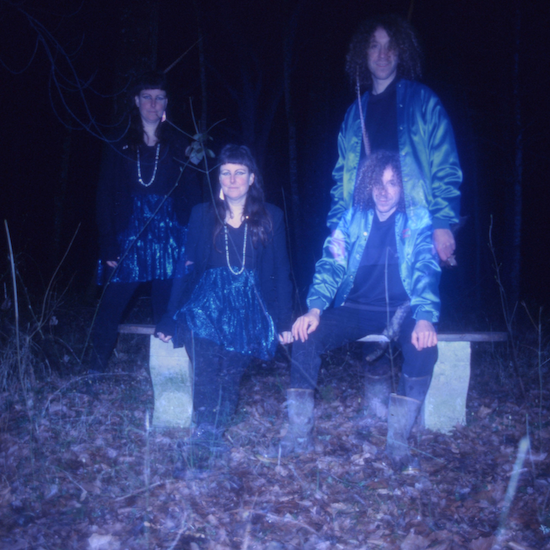Photos by Julien Bettoli
Bagpipes, the stars of Zohastre’s astonishing new album Abracadabra, stretch far back into the history of dance. Some will recognise the role of the zampogna (an Italian form of the instrument) in the traditional southern Italian ‘dance of the spider’, or ‘tarantella’. This fast-paced dance, typically performed in 6/8 time, originated in 15th century Taronto, where the native wolf spider’s venomous bite supposedly sent locals into a state of hysteria. “Originally you danced to get the poison out of your body,” explains Zohastre’s Héloïse Thibault, “but now the dancing is a way to get high somehow. The dancers and drummers try to upstage each other, playing faster and longer.”
These interests in movement, hysteria and history lie at the heart of Abracadabra. The French-Italian duo of Thibault and Olmo Guadagnoli combine live drums, analogue electronics and sampled bagpipes into a sizzling, dance-focused psychedelic record. While the tarantella gives its name to one track here, the other tracks drive towards similar states of mania, aided by dance rhythms and muscular drone. The climaxes are variously frightening – recalling the fireside dance in Lord Of The Flies – or unearthly. “There’s this idea of a threshold, entering a gate into this chaotic experience,” Guadagnoli says. “It’s like in 2001: A Space Odyssey when they get to the black hole, and from that point everything is –” he whooshes, making a tunnel with his hands.
The album finds various ways of celebrating bagpipes, as both a source of drone and a component in traditional dance music. They are often front-and-centre, from the rising loop opening ‘Dune’ to the euphoric break in ‘Esplumeor’. Elsewhere, they merge with the album’s squalling electronics or powerful synthetic drone (as in ‘El Tuco’). “In the first record, we were more into bagpipes from Scotland and Brittany,” Guadagnoli says, referring to 2018’s Pan And The Master Pipers. “On this one we use more of the biniou – a bagpipe from rural France – and the zampogna from southern Italy: a bigger one where the sound is more guttural. In all those bagpipes there is drone, which is sometimes very high-pitched, and sometimes very bassy. All the tracks are built listening to this drone, and trying to find ways of interacting with it.”
Neither member performs bagpipes on the album themselves. “We found physical tapes in my grandparents’ cassette collection, and a bunch in Italy,” Thibault explains. The duo would take these found recordings, and loop or sample them. “It’s interesting seeing people react to that sound – like a collective memory,” Thibault says of their live sets, where these loops are played in prepared cassettes. “It’s a way of taking this music from the past, and projecting it into a new place.”
This underscores the album’s unusual presentation of time, combining medieval European folk dance traditions, analogue synths reminiscent of early electronica, and shades of contemporary rock ranging from metal to noise. “In this record, the trick is to get you outside of time,” Thibault says, suggesting this is most central to ‘Spleen’. “It refers to the middle of the night, when the party is in full swing, but you can feel the day coming back – you’re between worlds and times,” she says. “There’s all these games, between the past, the distant past, and the present.”
One example is the closing track ‘Rondes Et Chansons’, referring to an old French book of traditional songs for children. “We have a kid, and I found this book. I remembered these songs perfectly” Thibault grins. “Looking at the pages, I started singing them. It’s the same process of how music can go through generations.” This fed into the presentation of time in this final song, which deals with “going back to the childish feeling of being in the present.” The bagpipes appear to freeze and glitch, emphasised by the stuttering character of Guadagnoli’s blast beats. While the bagpipe opening echoes that of ‘Dune’, Zohastre trade the former’s gradual escalation for a consistent, flat-out approach. “This moment is playful and mystical. It’s this happy breakcore, glitchy moment of joy.”
Alongside these sensibilities from electronica and folk dance, the album is shaped by ideas from rock music. This is derived principally from Guadagnoli’s live drums, moving in ‘Spleen’ from a sludgy psych pattern – piercing the track’s muscular drone with bell cymbals – to metal blast beats. “It’s a very important part of our background. We grew up listening to Nirvana, Soundgarden, Melvins and all this rock” Guadagnoli says. He links this to the physicality of the duo’s live sets, in which he plays a live drum kit while Thibault manipulates a table of electronics. “We’re more like a rock duo than an electronic duo.”
As its title suggests, Abracadabra is also concerned with the concept of magic and its relationship with dancing traditions. “The world is magic, and we are magic,” Thibault says. “The idea is to reveal the magic around us, and inside of us. Dancing provokes this altered state of consciousness: it opens something which isn’t all intellectual.”
“It’s becoming something else, transforming yourself. As human beings, sometimes we feel very trapped in our bodies,” Guadagnoli adds. This notion of shapeshifting is reflected in the record’s textural changes: amidst the rising tempo of ‘Esplumeor’ a growing, twisting barrage of noise unexpectedly shifts into a chorus of bagpipes. Its title is drawn from Arthurian legend, referring to the site where the wizard Merlin – capable of transforming into different creatures and shapes – would resume his human form.
Guadagnoli associates this focus on magic with the band’s linking of medieval and contemporary musical practices. “In the past, this idea of magic was very important” he says. “For us, it was important to link this feeling to modern times. Magic is something we need to keep hold of and spread: telling stories about it is a good way of keeping the magic alive.”
In addition to fantasy, this album has been heavily influenced by ideas from science-fiction. The diving, oscillating synths and beeps heard throughout Abracadabra, most clearly in ‘Spleen’, are redolent of the genre’s soundtracks from the 70s and 80s. “While dancing, we are linked to an earthly feeling. Sci-fi is more linked to a stellar dimension,” Thibault says. Opening track ‘Dune’ is titled in tribute to Frank Herbert’s novel of the same name. “You get that dimension of time stretching, being lost in time, and time travel.”

This title also underscores ABRACADABRA’s wider use of song-titles to present movement through time and space. Its other titles reference Arthurian legend, medieval dance, traditional French song and ‘El Tuco’: the titular ‘ugly’ in Sergio Leone’s 1966 film The Good, The Bad And The Ugly. “He could be the most sci-fi character of all,” Thibault laughs. “This strange, cowboy time traveller.”
Beyond their work in Zohastre, Thibault and Guadagnoli also run the excellent record label ZamZam: responsible for releases by the likes of Gnod, Orryx and MXLX, as well as Zohastre themselves. “We created ZamZam as musicians, so it’s not so separate,” Thibault says when asked about how this relates to Zohastre. However, their perspective as musicians has fed into the seriousness with which they approach their label duties. “The attention we pay to our own record, we give it to all the musicians we work with as well.”
“We release and have met a lot of musicians, so we get a lot of inspiration” Guadagnoli adds. Beyond the apparent convenience of releasing through their own label, the band also see ZamZam as a clear fit for the kind of music they’re making. “Those questions of magic, time, bringing stuff to the future: that’s what we’re looking for when we release music as a label.”
The record’s interest in dancing and movement prompts reflection on the band’s live shows, which deal heavily in improvisation. “Live, we play facing each other in the middle of the crowd” Thibault explains, suggesting this helps the band and the crowd respond to each other. “It’s a communal experience – where the public is taking us, we’re taking them. There’s an energy thing going on, and it’s different all the time.”
Zohastre’s combination of ideas from folk-dance traditions, rock and electronica has resulted in an electrifying, highly original album. What proves most interesting about it though, is its use of the bagpipes – here reconsidered as a kind of early drone instrument – to reach back through musical and cultural history. “This drone concentrates all the vibes,” Guadagnoli grins. “These things that come from the past, and we can bring into the future.”
Zohastre’s new album Abracadabra is out now via Zam Zam



